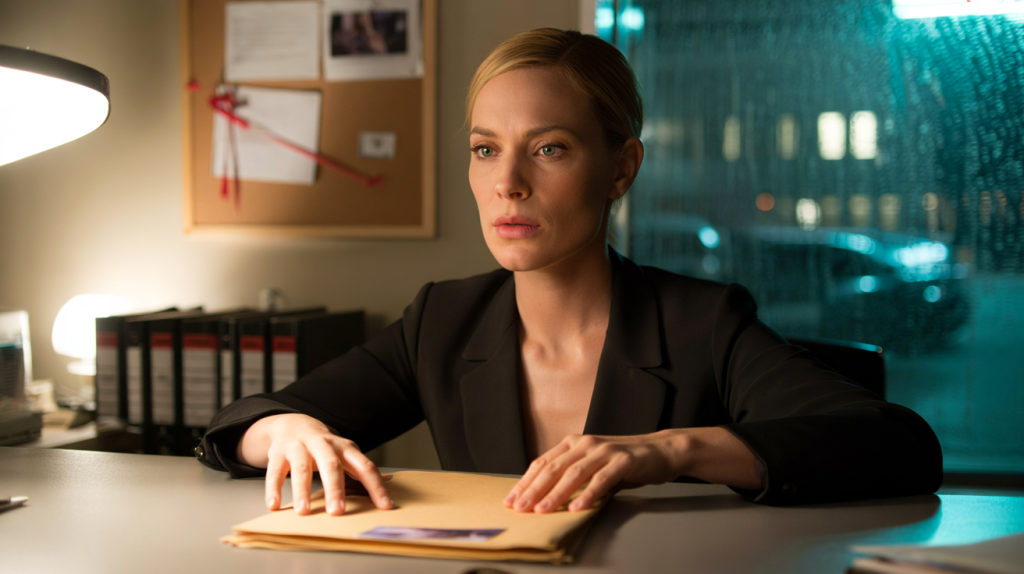There are performances that shout and performances that hold the room. In the thriller “Dossier 137”, Léa Drucker opts for the second path, a controlled, razor‑fine presence that tightens the story from the first exchange. No fireworks, just pressure. The kind that makes a viewer lean in and stop checking the phone.
Context matters. Léa Drucker is not arriving from nowhere. A César Award for Best Actress in 2019 for “Jusqu’à la garde” (2018), three seasons of “War of the Worlds” between 2019 and 2022, a filmography built on precision rather than noise. That background is the key to reading “Dossier 137”: a case driven not by twists piled high, but by small shifts in voice, gaze, and rhythm.
Léa Drucker in “Dossier 137” : the spine of a high‑stakes case
The main idea lands fast: the case feels impossible, and the character embodied by Léa Drucker carries the burden of proof minute after minute. Stakes are personal, yet the performance stays understated. She listens more than she speaks. She lets other characters reveal themselves, and by doing so, the plot tightens without the script screaming for attention.
That restraint solves a familiar thriller problem: exposition fatigue. Instead of dumping facts, the film lets the actor’s micro‑reactions do the heavy lifting. A tilted chin. A pause half a beat longer than expected. The audience receives the clue without the story stopping to underline it in red.
What the camera catches : details that power Léa Drucker’s performance
Plenty of viewers come to a legal or investigative drama looking for blazing monologues. Here, the power sits in another register. The camera often waits on Léa Drucker’s face after a line has been delivered by someone else. That beat, that breath, is where “Dossier 137” finds its tension.
Looking for the tell? Watch the hands. In “Jusqu’à la garde”, released in 2018, her controlled physicality turned a domestic scene into a powder keg. The same grammar returns, but leaner. She moves less. Every gesture counts, and each one recalibrates the scene’s balance of power.
To follow the thread more closely, here is a short checklist that helps decode the performance without spoiling the plot :
- Entrance energy: note how her first scene sets a baseline of calm that later cracks in precise increments.
- Voice placement: the register drops on confrontation, rises when probing. That shift signals who holds the advantage.
- Eye line: when she looks slightly off the partner, the tension is tactical, not emotional.
- Silence length: the longest pause often arrives right before a factual pivot in the case.
From “Jusqu’à la garde” to “War of the Worlds” : dates that explain today’s precision
The timeline helps. “Jusqu’à la garde” landed in French theaters in 2018, and the César Award for Best Actress followed in 2019. That recognition did not turn Léa Drucker louder; it made her choices sharper. Across three seasons of “War of the Worlds” between 2019 and 2022, she worked inside genre constraints while keeping emotions legible under pressure. Those years honed a toolset that “Dossier 137” now deploys scene after scene.
One more anchor: biography. Born on 23 January 1972, Léa Drucker comes from a family where public performance is part of the air, yet her screen work evolved in the opposite direction of showmanship. She trims, pares down, edits in the moment. The result in “Dossier 137” looks simple. It is not. It is the kind of simplicity achieved only after decades on sets and stages.
Where “Dossier 137” fits in Léa Drucker’s career arc
So what is the added value here? “Dossier 137” leverages a skill she has refined since 2018: letting the audience do part of the work. The character never over‑explains. The framing trusts viewers to read the micro‑signals. That trust changes the pacing and heightens the payoffs when facts click into place.
There is also structure at play. Scenes are built around contained confrontations that escalate by inches. When a reversal comes, it lands because the ground has been quietly prepared. That is where Léa Drucker’s approach proves decisive: consistent emotional mapping across the case, a clear internal logic, and no unecessary emphasis.
For anyone tracking her filmography, the performance in “Dossier 137” is not a detour, it is a consolidation. The same attention to silence seen in 2018, the endurance tested across 2019 to 2022, now focused on a single, tightly wound investigation. The missing element would be excess. It never arrives, and the film is stronger for that absence.
